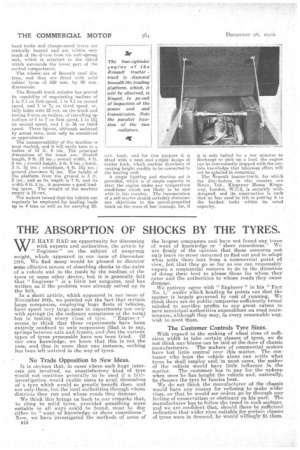THE ABSORPTION OF SHOCKS BY THE TYRES.
Page 10

If you've noticed an error in this article please click here to report it so we can fix it.
WE HAVE HAD an opportunity for discussing with experts and authorities, the article by " Engineer" on the subject of unsprung weight, which appeared in our issue of Deeeinher 12th. We find many would be pleased to discover some effective means of absorbing shocks to the axles of a vehicle and to the roads by the medium of the tyres or some other device, but it is generally felt that " Engineer" is a little too sanguine, and has written as if the problem were already solved up to the hilt.
In a short article, which appeared in our issue of November 28th, we pointed out the fact that certain large companies, employing huge fleets of vehicles, have spent very large sums in experiments not only with spring g (in the ordinary acceptance of the term) but in testing every class of tyre. " Engine a" seems to think that these experiments have been entirely confined to axle suspension (that is to say, springs between axle and frame), and that the various types of tyres procurable have not been tried. Of our own knowledge, we know that this is not the case, and that in more than one instance, nothing has been left untried in the way of tyres.
No Trade Opposition to New Ideas.
It is obvious that, in cases where such huge interests are involved, an unsatisfactory kind of tyre would not continue generally to be used if a little investigation would enable users to avail themselves of a tyre which would so greatly benefit them. and not only them, but, the local authorities through whose districts they run and whose roads they damage.
. We think this brings us back to our remarks that, to cling to solid tyres, provided something more suitable in all ways could be found, must be due either to " want of knowledge or sheer cussedness." Now, we have investigated the methods of some of B18 . the largest companies and have not fonrid any trace of want of knowledge or " sheer cussedness." We are firmly of the opinion that these concerns not only leave no stone unturned to find out and to adopt what suits them best from a commercial point of view, but that they go so far as one can reasonably expect a commercial concern to do in the direction of doing their best to please those for whom they cater and the authorities to whose roads they cause damage. We entirety agree with "Engineer " in his "Fact No. 1," under which heading he points out that the matter is largely governed by cost of running. We think there are no public companies sufficiently broad minded to sacrifice profits to any great extent to save municipal authorities expenditure on road maintenance, although they may, in every reasonable way. wish to meet them.
The Customer Controls Tyre Sizes.
With regard to the making of wheel rims of sufficient width to take certain classes of tyres, we do not think any blame can be laid at the door of chassis manufacturers. The makers of commercial motors have but little control over this matter. The customer who buys the vehicle alone can settle what tyres he shall emPloy and, in most cases, the maker of the vehicle would have little influence in the matter. The customer has to pay for the upkeep when once he has bought the vehicle and, naturally, he chooses the tyre he fancies best.
We do not think the manufacturer of the chassis would have any reason for refusing to make wider rims, or that he would see orders go by through any feeling of conservatism or obstinacy on his' part The manufacturer has to follow the trend in such matters, and we are confident that, should there be sufficient indication that wider rims suitable for certain classes of tyres were in demand, he Would -willingly fit them.






























